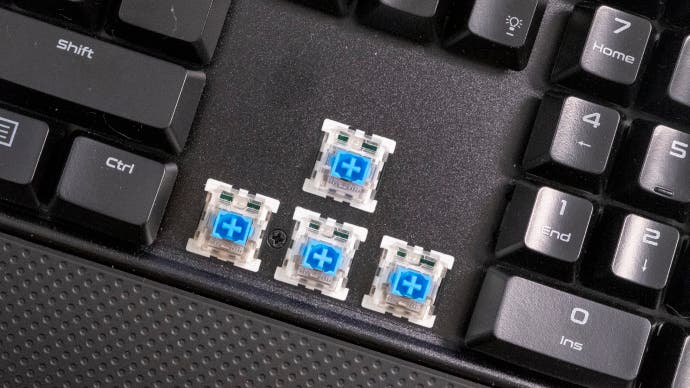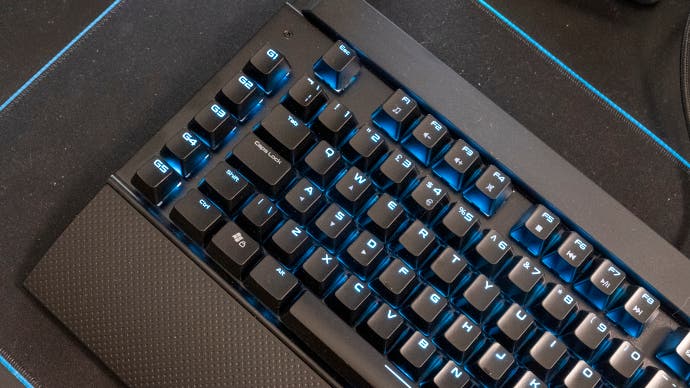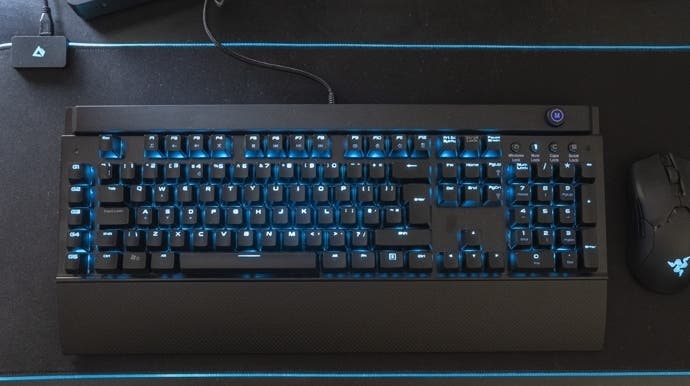Reviewed: Amazon's £23 mechanical gaming keyboard
The most mech for your money - but there's a catch.
Mechanical keyboards used to be super expensive. When Twitch and esports rose to prominence at the start of the last decade, kicking off a wave of interest in these mechanical marvels, the only options out there were Japanese imports built around German-made Cherry MX switches. These boards delivered a rock-solid typing and gaming experience, but even the cheapest examples cost upwards of £100 here in the UK. That's a ton of money to spend on a peripheral, but the high cost of each mechanical switch - around £1, with 105 keys needed - meant that manufacturers and retailers alike only made a tiny profit on each unit sold.
Since then, the original Cherry switches have been joined by a sea of imitators working to similar blueprints, bringing down the cost of mechanical keyboards at a rapid pace. Today we reach a new standard of affordability, as Amazon's Basics line has expanded to include a genuine full-fat, full-size mechanical keyboard that changes its price regularly, but at its lowest retails for just over £20. This is our review of the Amazon Basics Programmable Mechanical Gaming Keyboard - and after a week, we're impressed.

At £22.67 including shipping, the Amazon Basics keyboard cost me about £100 less than the first mechanical keyboard I ever bought, a Japanese-made Filco Majestouch-2. That Filco was built like an absolute tank and felt fantastic to type on after a life of mushy membrane keyboards, but it had a pretty short feature list - just 105 mechanical, plate-mounted switches beneath tasteful plastic keycaps, with nary a secondary function or RGB backlight in sight.
The Amazon keyboard, by contrast, includes 110 mechanical keys - thanks to the addition of five macro keys along the left side - plus individual RGB backlighting, media controls via a Function layer, a gaming mode and a palm rest. That would be a respectable feature list for a rubber dome keyboard that costs far less to produce, but for a mechanical keyboard at this price point it's nothing short of incredible.

Of course, a good mechanical keyboard isn't defined by its number of features. For me, the critical ingredient is a good typing feel, characterised by snappy, consistent feedback from each key press, with a hard-wearing and non-slippery keycap. Surprisingly, the Amazon Basics keyboard actually does pretty well here too. The blue Outemu switches deliver a satisfying click and tactile bump near the point of actuation, giving plenty of feedback - plus that signature mechanical clatter that definitely attracts the attention of your work colleagues. The amount of force required to push down each key does vary as you travel across the board - a common issue with budget mechanicals - but it's not something you're likely to notice outside of a head-to-head comparison.
The keycaps are reasonable too. They're ABS plastic, so they'll likely wear away over time and become a little too slick and shiny to be comfortable after years of use, but the entirely standard layout and standard MX switches mean you can swap them out for other keycap sets with ease. The chassis itself feels right too - there's a metal plate beneath the 'floating' keys, making it extremely resistant to deck flex and giving it a reassuring heft. Mechanical keyboards should last for decades if treated right, and this one shows no sign of weakness.

Backlighting is another clear point of differentiation between mechanical keyboards, especially at the budget end of the market. The Amazon Basics started promisingly, with the board cycling through several colours when you first connect it to show off its RGB credentials. However, once this chromatic parade is complete, the keyboard goes to a boring Razer green. Examining the keyboard, you'll find a way to adjust the backlight brightness, but there's no key to switch to a new effect or a new colour. For that functionality, you'll need to install the Amazon Basics gaming software, included on CD (!) in the box or available for download on the Amazon product page. That's a little disappointing, but the software does at least install quickly and it's very easy to use. As well as changing the backlighting, you can choose which keys are disabled in game mode (alt+tab, alt+f4 and the Windows key are all possible) and what each of the five macro keys do (sadly, the remainder of the keys aren't programmable).
It would have been nice to see more customisation possible on the keyboard itself, without the need for software, but this is largely a matter of taste. Unfortunately, that's not the only issue with the backlighting. We noticed that after changing the backlight colour from solid green to solid teal, the keyboard started behaving very oddly.

Every 30 seconds or so, the keyboard's lights would dim, change rapidly between different colours and then returning to teal. During that brief colour cycle, the keyboard would stop responding, almost as if its controller was locked up for those moments - and that means, out of a sentence, you'd often be missing a letter or two. When typing, that's annoying, but when gaming, that's rage-inducing - especially when your Counter-Strike matchmaking rank is on the line. Suddenly, that reload you wanted to pull off before that next enemy came around the corner just wouldn't happen - or that grenade you wanted to pull out remained in your back pocket, and instead of pulling the pin you were firing your weapon into a wall, uselessly.
In the end, the issue did work out to be fixable. While changing the effects and closing the software did nothing, turning down the backlight's brightness just one level solved the issue. I'm happy to have found a solution, but it's still a perplexing issue - and perhaps emblematic of the kind of corners that get cut in order to deliver a certain feature set at the lowest possible price.

Despite the brightness bug, I still found myself using the Basics keyboard for far longer than the review period required. Typing on those crunchy MX Blue switches is just satisfying, especially when you've got the house to yourself and you can create a joyous racket without worry. The full-size layout is convenient for a wide range of games, and the macro keys even came in handy for testing a few automation scripts. This is still a damn fine mechanical keyboard - and if you look on Amazon, by far the best option at the £20 price bracket.
There are strong alternatives that cost a little more from the likes of Tecknet, Havit and Qisan, but none of these offer a full UK layout, a wrist rest, macro keys and per-key RGB backlighting at the same low price that the Amazon Basics board does.

Unfortunately, that sub-£25 price point for this board is far from a given, with historical data showing that the keyboard has retailed for as little as £22 and as much as £60. You can certainly see the invisible hand of an algorithm in the price history graph, with characteristic ladders that show more-or-less daily price reductions to around £23 and then a sharp jump back to the £60 mark soon thereafter.
So - the Amazon Basics Mechanical Keyboard is definitely one to bookmark and check regularly, and if you're lucky you'll be able to catch it at that sub-£25 mark where it becomes exceptionally good value. As a risk-free introduction to mechanical keyboards, you won't find much better - just don't turn the brightness up all the way.
Got a little more to spend than £20? Check out our guides to the best gaming keyboards and the best mechanical keyboards. And if you want the absolutely least valuable item we've reviewed, check out I bought Puma's £80 esports shoes so you don't have to.









